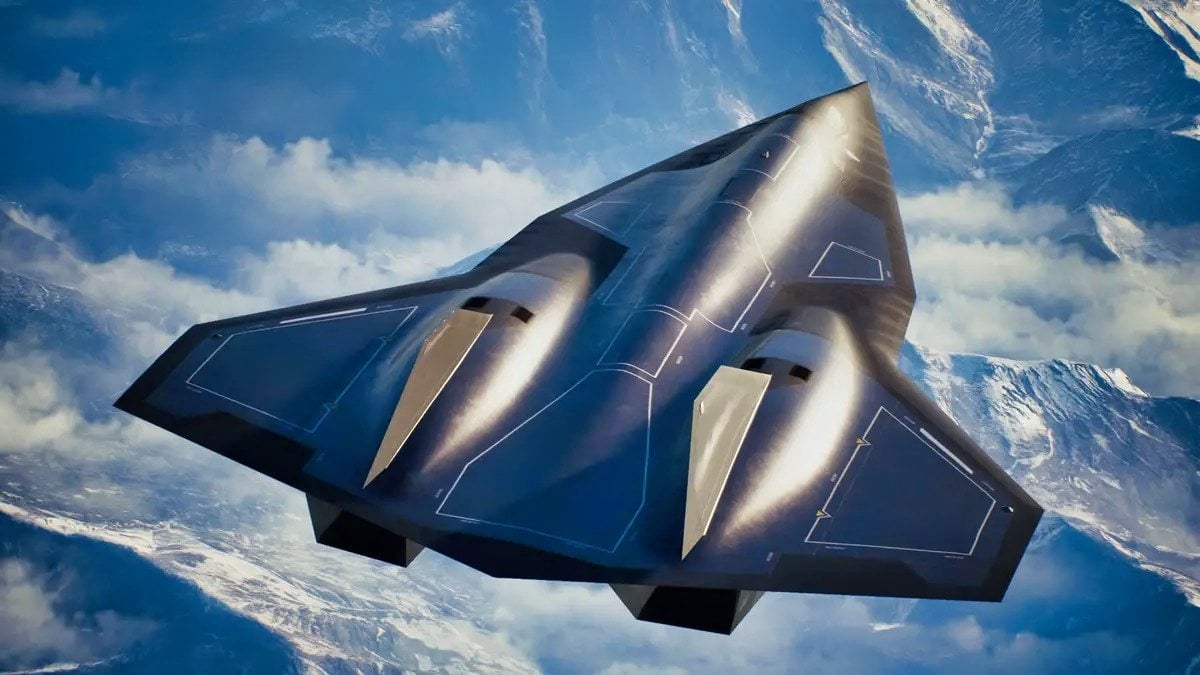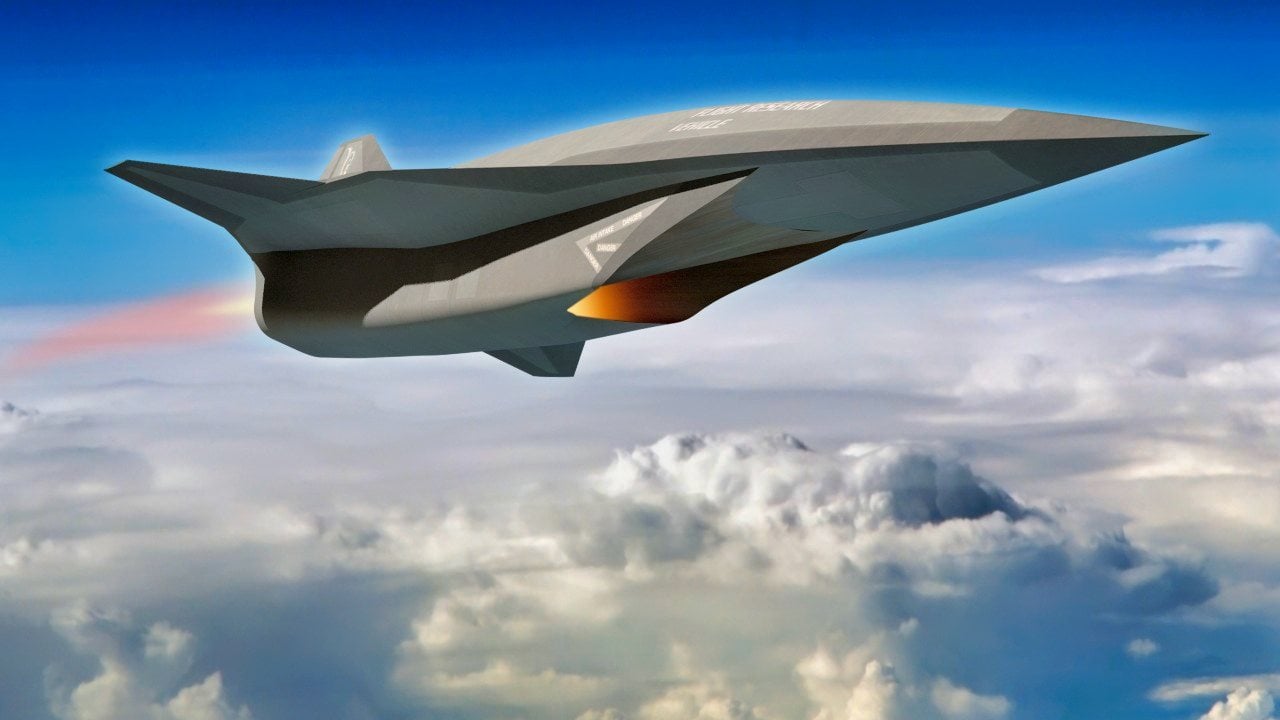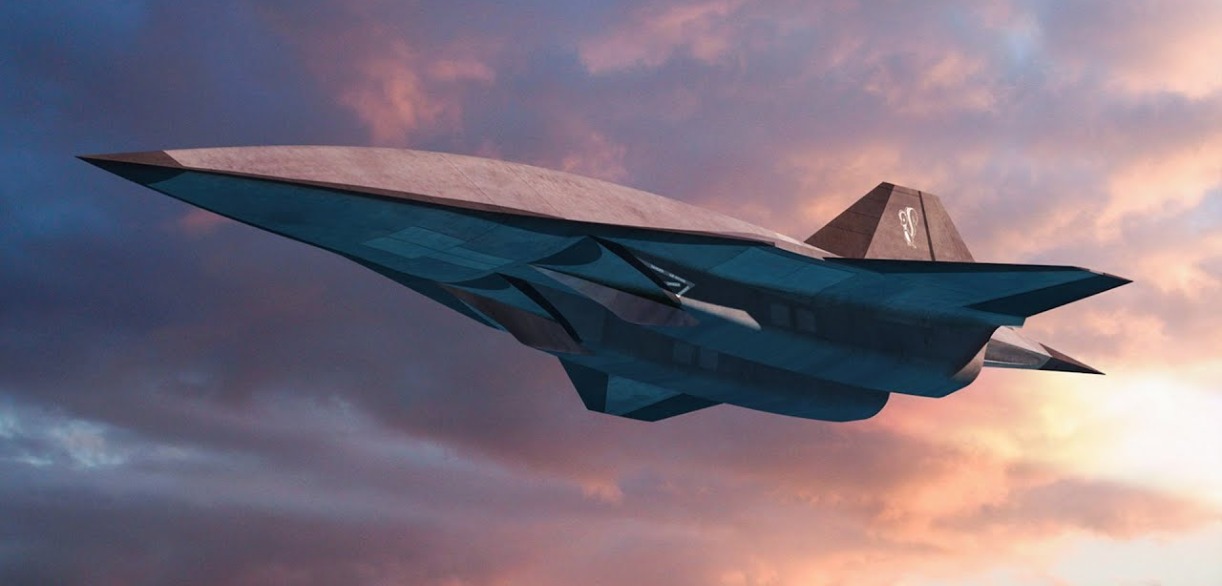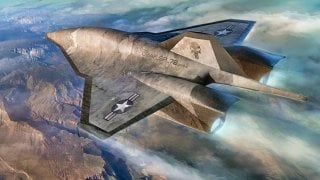Mach 6 SR-72 Son of Blackbird Could Soon Become Very Real
The SR-72 was once publicly touted as a Mach 6+ spy plane with strike capabilities, meaning this high-flying jet wouldn’t be limited to solely taking pictures like its Blackbird predecessor and would instead be capable of engaging targets directly on extremely short timelines and with minimal chance of intercept.
Summary and What You Need to Know: Lockheed Martin’s SR-72 hypersonic aircraft, a successor to the SR-71 Blackbird, is advancing toward service but faces significant budgetary challenges. Recent reports reveal the program has exceeded its budget by $45 million in Q2 2024, bringing total losses to $335 million since 2022. This overspending highlights ongoing financial strain, compounded by Lockheed’s self-funded development approach.
-Despite these issues, the SR-72’s potential—promised as a Mach 6+ aircraft with ISR and strike capabilities—remains high.
-The program's secrecy and Lockheed's expansion efforts suggest it is progressing toward operational status, potentially aligning with future U.S. Air Force needs.
Secretive SR-72 Hypersonic Aircraft Hits Financial Hurdles, Yet Shows Promise
Lockheed Martin’s mysterious hypersonic aircraft known as SR-72 appears to be continuing its march toward service, but the program is not immune from the Air Force’s broader budgetary woes.
Sandboxx News has covered the secretive development of SR-72, Lockheed Martin’s hypersonic successor to the legendary SR-71 Blackbird, and its potential path toward service in the not-too-distant future. Now, new evidence has come to light that suggests this exotic new aircraft program is facing compounding budgetary shortfalls, which could further complicate matters for the Air Force as it struggles to find ways to fund a bevy of high-profile new efforts, including new ICBMs, stealth bombers, and air superiority fighters.
The SR-72 was once publicly touted as a Mach 6+ spy plane with strike capabilities, meaning this high-flying jet wouldn’t be limited to solely taking pictures like its Blackbird predecessor and would instead be capable of engaging targets directly on extremely short timelines and with minimal chance of intercept.
Lockheed’s secret program went another $45 million over budget
According to recent Aviation Week reports, a classified Lockheed Martin program that involves a “highly complex design and systems integration” went another $45 million over budget in the second quarter of 2024. Based on Lockheed’s quarterly filing with the U.S. Securities and Exchange Commission, that places the firms’ total losses associated with this single shadowy program up to some $335 million since 2022. Those same filings went on to postulate that losses may continue to accrue as the company faces “advanced procurement costs” moving forward.
This all points toward what Aviation Week’s defense and space editor, Steve Trimble, describes as “pre-contract investments” made by Lockheed. It also suggests that the company is continuing to self-fund development based on the idea that the Pentagon will not only see the platform’s value, but will be willing to pay enough for a production fleet that will allow Lockheed to recoup its development losses.
This may seem like a rather unusual approach to developing such a high-dollar aircraft, but historically, it’s not really out of the ordinary for Lockheed Martin’s legendary Skunk Works.
In books by both Skunk Works founder Kelly Johnson and his direct successor, Ben Rich, there are accounts of several Skunk Works programs, like the D-21 supersonic ISR drone, that began as a bright idea Lockheed’s engineers knew the U.S. military or intelligence apparatus could very likely use, and which were then developed and pitched to decision-makers at the Pentagon.
More frequently, however, developmental efforts were spurred by hushed conversations between men like Kelly Johnson and senior Defense officials who relayed the nation’s most pressing needs hoping the Skunk Works hivemind might have a potential solution.
Famously, Johnson designed and delivered America’s first-ever jet-powered fighter in this manner, with formal design work on the XP-80 commencing a full four months before the firm was awarded a contract for the jet.

But in this modern era of bureaucratic oversight and extended design cycles, it seems unlikely that Lockheed Martin would have gone all-in on fielding the SR-72 without some pretty conclusive evidence from the Air Force that it’d eventually step in and foot the bill. The firm’s financial records seem to substantiate that likelihood.
“We will monitor the recoverability of pre-contract costs, which could be impacted by the customer’s decision regarding future phases of the program,” Lockheed said of this program in its filings.
While the SR-72 effort appears to have continued to progress under the classified veil since early 2018, word of these losses, combined with the rapid expansion of Lockheed Martin’s Skunk Works facilities and personnel, all point toward the production of a new classified aircraft meant not for testing, but likely, operational service.
What is the SR-72?
Lockheed Martin began development on a hypersonic successor to the Blackbird in 2006. The program continued in secret for seven years, before being formally announced to the public in 2013 with a media push that included several interviews with Lockheed Martin’s hypersonics program manager and the engineer who led the effort for the previous seven years, Brad Leland.
“Hypersonic aircraft, coupled with hypersonic missiles, could penetrate denied airspace and strike at nearly any location across a continent in less than an hour,” Leland was quoted as saying in a Lockheed Martin press release that has since been taken down. “Speed is the next aviation advancement to counter emerging threats in the next several decades. The technology would be a game-changer in theater, similar to how stealth is changing the battlespace today.”

This new high-speed aircraft would make use of a never-before-fielded type of engine that was, for all intents and purposes, two (or maybe even three) types of jet engines in one.
As Leland described it, this new propulsion system started with a conventional turbofan engine – either the Pratt & Whitney F100 or the General Electric F110 – as its basis. This turbofan would allow the aircraft to take off from a stop and accelerate to supersonic speeds like any normal fighter, but once the jet began to approach Mach 3, the engine’s second half would roar to life.
That second half is said to be a dual-mode ramjet (sometimes called a dual-mode scramjet or supersonic combustion ramjet) that relies on the immense pressure of inflowing air at supersonic speeds and a variable inlet design to create intentionally placed shockwaves for compression.
As a result, this engine design could propel an aircraft well past the SR-71’s record-setting top speed of Mach 3.2, past the notional hypersonic barrier at Mach 5, and potentially even past Top Gun’s fictional Darkstar (which was notably built in partnership with Skunk Works) at Mach 10.
This type of engine design, which has since become more commonplace, is known as a turbine-based combined cycle, or TBCC, engine. While Lockheed Martin was leading the design effort on the aircraft, Aerojet Rocketdyne was tasked with engine development.
Originally billed as a Mach 6+ aircraft, this new platform was slated from the start as an intelligence, surveillance, and reconnaissance (ISR) asset with strike capabilities. This meant the aircraft would be capable of carrying a variety of payloads, including munitions to engage ground targets.
While Leland highlighted the use of this new aircraft as a hypersonic missile launch platform, it now seems more likely that we’d see this hypersonic aircraft deploy lower-cost munitions designed specifically to be dropped or launched at hypersonic speeds. The hypersonic missiles the United States has in development come in a variety of forms, but all are considered to be immensely expensive compared to more traditional ordnance.
Due to the immense pressure and heat inherent to high-speed flight, there are significant – but not insurmountable – engineering challenges to overcome in order to drop or launch a weapon at these extreme speeds. Lockheed proved the viability of launching air-to-air missiles successfully at speeds over Mach 3 with the YF-12 (a weaponized sibling of the SR-71), and more recently, Sandboxx News confirmed this possibility of deploying weapons at much higher speeds with Dr. Chris Combs, a Dee Howard endowed professor of hypersonic and aerospace engineering for the University of Texas San Antonio, who has also done a great deal of work with the Defense Department in the past.

But the SR-72’s alleged strike capabilities aren’t the only important matter. The aircraft’s ability to provide rapid intelligence over any target on earth would be vital for the United States in a 21st-century conflict, especially over the sprawling expanses of the Pacific. Despite public perceptions of satellites providing constant global overwatch, the truth is, there aren’t enough satellites in orbit to have eyes everywhere needed, and the predictability of satellites’ orbits makes them fairly easy to keep secrets from.
This has driven the funding of a long list of modern intelligence-gathering aircraft, ranging from the original mascot of the Global War on Terror, the MQ-1 Predator, to highly exotic airframes we still don’t know the real names of, like the Northrop Grumman-sourced RQ-180.
Yet, despite America’s immense investment into spy planes in recent decades, all of these platforms (that we’re aware of) fly at subsonic speeds, making timely intelligence gathering a question of locality and airframe availability. The MQ-9, for instance, may be able to stay airborne for more than 24 hours at a time, but with a standard cruising speed of just 230 miles per hour, it would take a Reaper more than an hour to fly from New York to Boston and more than 10 hours to fly cross-country.
Conversely, a hypersonic aircraft traveling at Mach 6, or roughly 4,600 miles per hour, could fly from New York to Boston in under five minutes, and make the same New York to LA flight in about half an hour.
The road to SR-72 production began in 2018
As Sandboxx News has previously reported, in June 2017, Lockheed Martin’s executive vice president and general manager for Skunk Works, Rob Weiss, told the media that testing was complete on the turbine-based combined cycle hypersonic propulsion system for the SR-72 and that they were “getting close” to beginning work on what he described as an SR-72 Flight Research Vehicle (FRV). This single-engine technology demonstrator was said to be “about the size of an F-22 Raptor” and was meant to demonstrate the platform’s ability to take off under conventional turbofan power, accelerate up to supersonic speeds, and then transition from turbofan power to a much more exotic dual-mode scramjet that would allow the aircraft to achieve maximum speeds well above Mach 6.
By September 2017, eyewitness accounts of this Flight Research Vehicle flying over Palmdale, California, where Skunk Works is headquartered, began to surface.
Aviation Week took these SR-72 FRV reports to Lockheed Martin’s Orlando Carvalho, executive vice president of aeronautics, at the time, who did not deny the reports.
“Although I can’t go into specifics, let us just say the Skunk Works team in Palmdale, California, is doubling down on our commitment to speed,” Carvalho said.
In February 2018, another senior Lockheed Martin official, Vice President of Strategy and Customer Requirements in Advanced Development Programs Jack O’Banion, told the American Institute of Aeronautics and Astronautics SciTech Forum that the SR-72 FRV was already flying; he then told the Wall Street Journal, “The aircraft is also agile at hypersonic speeds, with reliable engine starts.”
But just as the SR-72 hype train was leaving the station, Russian President Vladimir Putin delivered an address that has since come to be known as the onset of the modern hypersonic arms race, in which he announced a slew of new Russian “doomsday weapons” were entering service, including two different Mach 5+ missile systems.
Almost immediately after Putin’s speech, Lockheed Martin stripped any mention of its highly-touted SR-72 program from its website and the parade of quotes from senior executives promptly stopped. The company did not announce the cancellation of the effort or any reason for a hiatus. It simply went about its business, at least publicly, as though the SR-72 had never existed. In our previous coverage, we posited that this dramatic shift may have been the result of the Pentagon stepping in with classified lines of accounting and a renewed need for secrecy following Putin’s announcement.
We now know that, behind closed doors, something big was brewing. By the end of the following year, Lockheed Martin had broken ground on the massive new factory that would become Building 648, and the hiring bonanza to staff this new facility had started even earlier than that.
The SR-72’s growing paper trail
In the second quarter of 2022, Lockheed reported a $225 million pre-tax loss on a classified Aeronautics program that had just completed a comprehensive review. Three months later, however, Lockheed Martin filings indicated that the customer for this effort had signed a “memorandum of agreement” to modify the scope and price of the contract. This implies that there is indeed a contract in place (seemingly a fixed-price incentive-fee contract), and that Lockheed Martin is unlikely to have to swallow these cost overruns on its own. With continued budgetary overruns now reaching $335 million, it stands to reason that the program’s overall budget is significantly more.
But that’s not the only evidence pointing toward a highly secretive aircraft being developed for the U.S. Air Force. In fact, there’s a fair bit of evidence to suggest that this program has matured beyond development and pre-production tooling, and is likely beginning a full production run. In particular, there’s the construction of a massive new production facility at the Skunk Works headquarters in Palmdale, California, dubbed Building 648 – along with the hiring of thousands of new personnel tasked with building… something inside.
Construction on Building 648 was completed in August 2021, with Lockheed Martin touting the massive 215,000-foot structure as an “intelligent, flexible factory” aimed at reducing the significant investments of both time and money required to stand up new production lines. This is accomplished, Lockheed Martin explained, through the use of advanced artificial intelligence, augmented reality, and large, broadly capable robots known as Combined Operation: Bolting and Robotic AutoDrill systems, or COBRAs.
As Skunk Works revealed at the time, they had already demonstrated the functionality of these new robots in the production of the technology testbed that would lead to the X-59A Quiet Supersonic Transport testbed, or QueSST, but based on other publicly available information, Skunk Works is up to much more than building one or two technology demonstrators inside Building 648.
Hiring an army for ‘advanced development programs’
Between February 2018, when the SR-72 went dark, and September 2023, Lockheed Martin increased the size of the advanced development programs unit, a subsidiary of their aeronautics division, by a whopping 75 percent, hiring more than 2,300 new employees over five years, with hundreds of openings still advertised on their careers page.
There are also statements from Skunk Works officials that highlight that low-rate production of something is underway.
“I think it’s fair to say that there is low-rate production going on in the Skunk Works,” Skunk Works General Manager John Clark told the press in 2022. “We’ve got our hands in a myriad of activities, so I feel comfortable saying that because you won’t be able to factor in specifically what it might be to then create security problems for me. But yes, there are low-rate production activities going on in Palmdale.”
Clark went on to say that, while the Skunk Works may be renowned for its rapid prototyping capabilities, the secretive organization has always been a manufacturing center for advanced airframes like the SR-71 and F-117, once again emphasizing that his team at Skunk Works wasn’t dedicated solely to fielding exotic prototypes, but high-end operational aircraft as well.
“I’ve really tried to reinforce that mindset that we do more than just a one-off X-plane,” Clark said. “It has given me a lot more freedom with the aeronautics executive leadership team to let me grow Skunk Works the way that it historically would have been grown.”
Will the SR-72 break cover soon?
In an episode of the Defense & Aerospace Air Power Podcast late last year, Vago Muradian, the editor-in-chief of the Defense & Aerospace Report, brought up the RQ-180 – a high-flying stealth reconnaissance aircraft so secretive the U.S. government has yet to even acknowledge its existence, despite it being photographed in flight several times in recent years. The high-flying RQ-180 (the platform’s actual name is unknown) is expected to replace America’s venerable U-2 Spy Plane, as well as the RQ-4 Global Hawk, in the coming years.
But Muradian didn’t stop there.
“There is another program, however, which is for a much more capable reconnaissance aircraft that is the product of the Skunk Works and it is Lockheed Martin aircraft. There are articles that have already been delivered but that there have been challenges with that program,” he said.
“My understanding is that the program was re-scoped because it is that ambitious a capability that [it] required a little bit of re-scoping in order to be able to get to the next block of aircraft,” Muradian added.
Thus far, there has been no further confirmation of Muradian’s claims, but many see him as a credible source, and his proposed timeline seems to coincide with both the unanticipated costs Lockheed Martin has since had to swallow and what we know about the firm’s expansion.
Rumors of Lockheed Martin’s SR-72 program may have once been dismissed as nothing more than flights of fancy within the aviation community, but in the years since this effort began, the technology required to make this aircraft fly has gone from verging on science fiction to the sort of thing a plucky group of upstarts can pull off in an industry park. And that’s not hyperbole — as we speak, Atlanta-based startup Hermeus is continuing to ground test its Quarterhorse Mk 1 flying technology demonstrator with the platform’s first true flight test expected to occur any day now.
This uncrewed aircraft has hypersonic aspirations of its own, and intends to achieve them using a similar approach to propulsion. Hermeus’ Chimera turbine-based combined cycle engine, made up of a J85 turbojet followed by a ramjet, demonstrated its ability to transition from turbojet to ramjet power inside a highspeed wind tunnel nearly two years ago. The company has already begun work on the much larger Chimera 2, which swaps out that small J85 turbojet for a much larger F100 turbofan; notably, one of the engines Lockheed Martin identified as the turbine basis for their own, similar engine design.
Hermeus intends to field a new technology demonstrator each year as it progresses toward fielding its twin-engine Dark Horse military aircraft. Dark Horse probably won’t manifest until well into the 2030s, which is a similar timeline to the one offered by Lockheed Martin’s execs before the SR-72 program went dark.
In 2022, the Air Force Research Lab awarded a $334 million developmental contract to Leidos to field a very similar TBCC aircraft, dubbed Mayhem, for ISR and strike missions, though the company has subsequently wound down development on this program citing insufficient operational demand, potentially because there were already two similar and promising platforms in development (the SR-72 and Quarterhorse) drawing funds from Pentagon coffers.
In 2021, Pratt & Whitney announced its own efforts at fielding a unique kind of high-speed air-breathing jet engine system that wouldn’t rely on a traditional turbofan-to-scramjet design to achieve speeds just below the hypersonic barrier. And in January 2024, GE Aerospace announced its own progress in fielding a rotating-detonation-equipped dual-mode ramjet that it intends to marry to a turbofan to create what could be the smallest, lightest, and most powerful TBCC powerplant ever conceived.
So, at this point, it does seem all but inevitable that the United States will field a reusable hypersonic aircraft in the not-too-distant future. Whether that aircraft is produced by Lockheed Martin, Hermeus, or another company is uncertain but based on the evidence at hand, it appears that Lockheed may have secured a commanding lead. If low-rate initial production has already commenced on the SR-72, it could mean a similar timeline to service as the B-21 Raider with an anticipated service entry just before the close of the decade.
About the Author: Defense Expert Alex Hollings
Alex Hollings is a writer, dad, and Marine veteran.
This article was first published by Sandboxx News.
All images are Creative Commons and/or Shutterstock.


